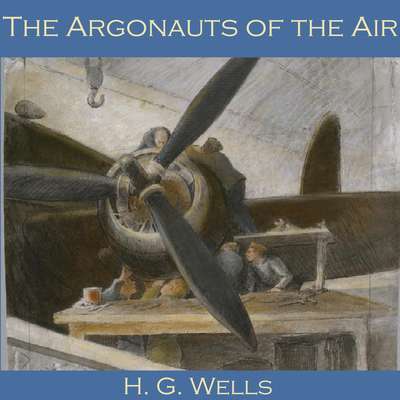“The Argonauts of the Air” is a short story by the English author H. G. Wells (1866–1946), about an unsuccessful early attempt at powered flight. First published in Phil May’s Annual in 1895 – eight years before the first flight of the Wright Flyer in 1903 – it was reprinted in The Plattner Story and OthersCollection of 17 short stories by H. G. Wells, first published in 1897. (1897).[1] The story is told by an unnamed third-person narrator.
Synopsis
“A massive alley of interlacing iron and timber” extending almost two miles (3.2 km) has become a familiar landmark for commuters travelling by train between Wimbledon and Worcester Park in south-west London. From time to time onlookers are treated to the sight of a “white monster” rushing through the structure before smashing into buffers at its terminus.

audiobookstore.com
The structure is the brainchild of Monson, a millionaire who for several years has been engaged in a project to build a flying machine. On the fifth anniversary of the project’s inception, Monson expresses his frustration at the repeated delays and overall lack of progress, and is beginning to run out of money. He is also stung by the public’s indifference to his efforts, reflected in the nickname the huge structure designed to launch his flying machine has acquired, Monson’s folly.
Monson persuades his engineer Woodhouse to agree to a flight, despite the latter’s reservations over the craft’s steering mechanism, a spoked wheel that alters the angle of the wings. The flying machine is designed to soar and glide much as a bird does, and is powered by two propellers driven by small petrol engines; the purpose of the long steel structure is to accelerate the craft to its takeoff speed. The two men succeed in launching their machine into the air, but almost immediately encounter problems in trying to steer it. They fly over Fulham and Primrose Hill towards Kensington Gardens, but lose control and are flung out of the machine just before it crashes into the Royal College of Science and bursts into flame.
“Though he [Monson] failed, and failed disastrously, the record of Monson’s work remains a sufficient monument – to guide the next of that band of gallant experimentalists who will sooner or later master this great problem of flying”.
Commentary
Hiram Maxim – inventor of the Maxim machine gun – installed a steam-powered aeroplane at his home, Baldwyn Park in Bexley. It ran on an 1800-foot (549 m) track with outriggers to prevent it from taking off, much like a modern roller coaster. On 31 August 1894 the machine briefly became airborne on an unintended flight, after breaking free of its restraints. Wells was clearly aware of Maxim’s design, as he describes in “The Argonauts of the Air” how Monson has modified the shape of Maxim’s wings.[2]
“The Argonauts of the Air”, anticipates the theme of experiments with flying machines that Wells developed in his novel Tono-Bungay (1909).[1]
See also
- H. G. Wells bibliographyList of publications written by H. G. Wells during the more than fifty years of his literary career.
